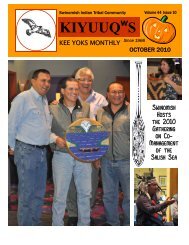April 2012 - Swinomish Indian Tribal Community
April 2012 - Swinomish Indian Tribal Community
April 2012 - Swinomish Indian Tribal Community
Create successful ePaper yourself
Turn your PDF publications into a flip-book with our unique Google optimized e-Paper software.
swədəbš qyuuqs<br />
Page 10<br />
Native Business: The Life-Giving and Crushing Power of Debt<br />
Debt is something owed to another party and most often is accompanied<br />
by an interest rate charged to the borrower for the use of money.<br />
In business, debt is good when you have a source of repayment. Debt<br />
is bad when a clear source of repayment does not exist. Start ups are<br />
most often capitalized by savings from the entrepreneur, money from<br />
friends and family, or home equity. There is no one-correct way to use<br />
money; each borrower has to decide for themselves. This article simply<br />
illustrates best practices to remember when thinking about borrowing<br />
money.<br />
A business owner should consider using debt when they need dollars<br />
to increase the delivery of a product or service to meet demand from<br />
existing or new customers. If it is an existing business, often contracts<br />
for service or orders for more products are in-hand. An entrepreneur<br />
would borrow money after they have demonstrated at least one or<br />
more successful transactions and need money to increase their workforce<br />
or purchase equipment to take their business to the next level of<br />
operating size. A brand new business without a history of sales usually<br />
has a high level of expertise in the respective industry and elects to<br />
borrow money when there is a relationship with a customer that guarantees<br />
sales at start-up.<br />
An entrepreneur should be cautious about borrowing money when a<br />
good idea comes with a large price tag for start up. This often means<br />
the individual needs to use some sort of debt borrowed from a 3 rd party<br />
to spend on things they think they need to get started. My advice, as a<br />
seasoned lender, is to not borrower at start-up if you can help it and<br />
instead start as small as possible.<br />
Often an entrepreneur will find their sales are slower to make or<br />
longer to collect than they initially thought. This requires patient capital;<br />
meaning if they used their own money or the money from family<br />
that does not need to be paid back until enough profits are generated,<br />
they will have more time for their business to mature. At the beginning,<br />
if an entrepreneur borrows money from a 3 rd party (like a bank),<br />
they are required to make monthly payments which include principal<br />
and interest which often lessens the amount of time a business can<br />
take to mature. These obligations (monthly payments) must be met<br />
on time and in the full amount owed or the borrower may trigger a<br />
series of compounding problems such as late fees, an increase to<br />
their loan’s interest rate or worse- be declared in default where the<br />
lender requests immediate payment. These consequences caused by<br />
late or non-payment consume cash that otherwise would be retained<br />
in the business. A business dies if it runs out of cash.<br />
Jim Stanley is a tribal member of the Quinault<br />
Nation, Past-Vice President of the Quinault<br />
Nation Enterprise Board, and board member of<br />
the Northwest Native American Chamber. He<br />
is a senior lender with Craft3, a non-profit loan<br />
fund lending to Sovereign Nations and tribal<br />
member owned businesses. Jim freely shares<br />
his knowledge and can be reached for comment<br />
at: jstanley@craft3.org.<br />
Section 184 Home Loan Program for<br />
<strong>Swinomish</strong> <strong>Tribal</strong> Members<br />
The <strong>Swinomish</strong> Senate has been informed that the Tribe’s request to<br />
participate in the HUD subsidized 184 Home Loan Program has been<br />
granted.<br />
The HUD 184 program offers home loans with:<br />
• Low interest rates based on current market rates (rather than<br />
credit scores)<br />
• Low down payments<br />
• 2.25% on loans over $50,000.00<br />
• 1.25% on loans under $50,000.00<br />
On <strong>April</strong> 25 th Shelter Bay will join<br />
the <strong>Swinomish</strong> Tribe for the annual<br />
<strong>Swinomish</strong> Earth Day event<br />
by participating in the <strong>Community</strong><br />
Service Projects.<br />
Approval of the loan requires a 1% loan guarantee fee paid at closing,<br />
which can be financed.<br />
The HUD 184 program requires that the borrower show that they have<br />
enough income to pay back the loan. This is based on the ratio of the<br />
borrower’s debt to income. Under the Section 184 program, total<br />
monthly debts including the loan typically cannot be more than 41% of<br />
gross monthly income.<br />
The loan can be used, both on and off the <strong>Swinomish</strong> Reservation, to<br />
Purchase an existing home<br />
Rehabilitate an existing home<br />
Construct a new home<br />
Refinance a current loan<br />
For information packets containing instructions on how to obtain a<br />
loan, a list of approved lenders, frequently asked questions, and requirements<br />
of the program, please see John Petrich at the <strong>Swinomish</strong><br />
Housing Authority.<br />
Join in to help clean up<br />
the area around the<br />
Shelter Bay Sign!
















